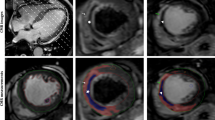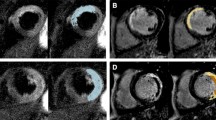Abstract
Data on the efficacy of excimer laser coronary atherectomy (ELCA) for patients with ST-elevation myocardial infarction (STEMI) are limited. Therefore, we sought to evaluate the impact of ELCA on myocardial salvage using nuclear scintigraphy in patients with STEMI. Between September 2014 and April 2017, we retrospectively enrolled 316 consecutive patients undergoing primary PCI (p-PCI) after their first STEMI in our institute. Of those, 72 patients with STEMI, an initial thrombolysis in myocardial infarction (TIMI) flow-0/1, and an onset to balloon time (OBT) < 6 h were included (ELCA, n = 32; non-ELCA, n = 40). The endpoint was the myocardial salvage index (MSI) based on a 17-segment model with a 5-point scoring system. MSI was calculated as: MSI = (∑123I-BMIPP defect score at 3–7 days after p-PCI - ∑99mTc-tetrofosmin defect score at 3–6 months after p-PCI)/∑123I-BMIPP defect score × 100 (%) at 3–7 days after p-PCI. The groups were compatible except in age (ELCA: 62.9 ± 12.4 years vs. non-ELCA: 69.8 ± 11.0 years) and loading antiplatelet drug (prasugrel: 100% vs. 40.0%). Direct implantation of shorter stents more frequently occurred in the ELCA group than in the non-ELCA group. MSI seemed to be better in the ELCA group compared with the non-ELCA group (57.6% vs. 45.6%, p = 0.09). This trend was emphasized when the final TIMI-3 flow was achieved (67.1% vs. 45.7%, p = 0.01). The nuclear scintigraphy results showed that ELCA can potentially improve myocardial salvage in patients with STEMI with OBT < 6 h and initial TIMI flow-0/1.




Similar content being viewed by others
References
Reimer KA, Hill ML, Jennings RB (1981) Prolonged depletion of ATP and of the adenine nucleotide pool due to delayed resynthesis of adenine nucleotides following reversible myocardial ischemic injury in dogs. J Mol Cell Cardiol 13(2):229–239
Giugliano RP, Braunwald E (2003) Selecting the best reperfusion strategy in ST-elevation myocardial infarction: it's all a matter of time. Circulation 108(23):2828–2830. doi:https://doi.org/10.1161/01.cir.0000106684.71725.98
Morishima I, Sone T, Mokuno S, Taga S, Shimauchi A, Oki Y, Kondo J, Tsuboi H, Sassa H (1995) Clinical significance of no-reflow phenomenon observed on angiography after successful treatment of acute myocardial infarction with percutaneous transluminal coronary angioplasty. Am Heart J 130(2):239–243
Morishima I, Sone T, Okumura K, Tsuboi H, Kondo J, Mukawa H, Matsui H, Toki Y, Ito T, Hayakawa T (2000) Angiographic no-reflow phenomenon as a predictor of adverse long-term outcome in patients treated with percutaneous transluminal coronary angioplasty for first acute myocardial infarction. J Am Coll Cardiol 36(4):1202–1209
Tanaka A, Kawarabayashi T, Nishibori Y, Sano T, Nishida Y, Fukuda D, Shimada K, Yoshikawa J (2002) No-reflow phenomenon and lesion morphology in patients with acute myocardial infarction. Circulation 105(18):2148–2152
De Luca G, Ernst N, Zijlstra F, van 't Hof AW, Hoorntje JC, Dambrink JH, Gosslink AT, de Boer MJ, Suryapranata H (2004) Preprocedural TIMI flow and mortality in patients with acute myocardial infarction treated by primary angioplasty. J Am Coll Cardiol 43(8):1363–1367. https://doi.org/10.1016/j.jacc.2003.11.042
Ito H (2011) The no-reflow phenomenon associated with percutaneous coronary intervention: its mechanisms and treatment. Cardiovasc Interv Ther 26(1):2–11. https://doi.org/10.1007/s12928-010-0034-z
Ikari Y, Sakurada M, Kozuma K, Kawano S, Katsuki T, Kimura K, Suzuki T, Yamashita T, Takizawa A, Misumi K, Hashimoto H, Isshiki T (2008) Upfront thrombus aspiration in primary coronary intervention for patients with ST-segment elevation acute myocardial infarction: report of the VAMPIRE (VAcuuM asPIration thrombus REmoval) trial. JACC Cardiovasc Interv 1(4):424–431. https://doi.org/10.1016/j.jcin.2008.06.004
Vlaar PJ, Svilaas T, van der Horst IC, Diercks GF, Fokkema ML, de Smet BJ, van den Heuvel AF, Anthonio RL, Jessurun GA, Tan ES, Suurmeijer AJ, Zijlstra F (2008) Cardiac death and reinfarction after 1 year in the thrombus aspiration during percutaneous coronary intervention in acute myocardial infarction study (TAPAS): a 1-year follow-up study. Lancet 371(9628):1915–1920. https://doi.org/10.1016/s0140-6736(08)60833-8
Frobert O, Lagerqvist B, Olivecrona GK, Omerovic E, Gudnason T, Maeng M, Aasa M, Angeras O, Calais F, Danielewicz M, Erlinge D, Hellsten L, Jensen U, Johansson AC, Karegren A, Nilsson J, Robertson L, Sandhall L, Sjogren I, Ostlund O, Harnek J, James SK (2013) Thrombus aspiration during ST-segment elevation myocardial infarction. N Engl J Med 369(17):1587–1597. https://doi.org/10.1056/NEJMoa1308789
Jolly SS, Cairns JA, Yusuf S, Meeks B, Pogue J, Rokoss MJ, Kedev S, Thabane L, Stankovic G, Moreno R, Gershlick A, Chowdhary S, Lavi S, Niemela K, Steg PG, Bernat I, Xu Y, Cantor WJ, Overgaard CB, Naber CK, Cheema AN, Welsh RC, Bertrand OF, Avezum A, Bhindi R, Pancholy S, Rao SV, Natarajan MK, ten Berg JM, Shestakovska O, Gao P, Widimsky P, Dzavik V (2015) Randomized trial of primary PCI with or without routine manual thrombectomy. N Engl J Med 372(15):1389–1398. https://doi.org/10.1056/NEJMoa1415098
Jolly SS, Cairns JA, Yusuf S, Meeks B, Gao P, Hart RG, Kedev S, Stankovic G, Moreno R, Horak D, Kassam S, Rokoss MJ, Leung RC, El-Omar M, Romppanen HO, Alazzoni A, Alak A, Fung A, Alexopoulos D, Schwalm JD, Valettas N, Dzavik V (2015) Stroke in the TOTAL trial: a randomized trial of routine thrombectomy vs. percutaneous coronary intervention alone in ST elevation myocardial infarction. Eur Heart J 36(35):2364–2372. https://doi.org/10.1093/eurheartj/ehv296
Denktas AE, Anderson HV, McCarthy J, Smalling RW (2011) Total ischemic time: the correct focus of attention for optimal ST-segment elevation myocardial infarction care. JACC Cardiovasc Interv 4(6):599–604. https://doi.org/10.1016/j.jcin.2011.02.012
Shiomi H, Nakagawa Y, Morimoto T, Furukawa Y, Nakano A, Shirai S, Taniguchi R, Yamaji K, Nagao K, Suyama T, Mitsuoka H, Araki M, Takashima H, Mizoguchi T, Eisawa H, Sugiyama S, Kimura T (2012) Association of onset to balloon and door to balloon time with long term clinical outcome in patients with ST elevation acute myocardial infarction having primary percutaneous coronary intervention: observational study. BMJ 344:e3257. https://doi.org/10.1136/bmj.e3257
Ilkay E, Karaca I, Yavuzkir M, Akbulut M, Pekdemir M (2005) The effect of interventional treatment in acute myocardial infarction on ST resolution: a comparison of coronary angioplasty with excimer laser angioplasty. Angiology 56(4):377–384. https://doi.org/10.1177/000331970505600403
TIMI Study Group (1985) Infarction (TIMI) trial. Phase I findings. N Engl J Med 312(14):932–936. https://doi.org/10.1056/nejm198504043121435
Gibson CM, Cannon CP, Daley WL, Dodge JT Jr, Alexander B Jr, Marble SJ, McCabe CH, Raymond L, Fortin T, Poole WK, Braunwald E (1996) TIMI frame count: a quantitative method of assessing coronary artery flow. Circulation 93(5):879–888
Tamaki N, Morita K, Kuge Y, Tsukamoto E (2000) The role of fatty acids in cardiac imaging. J Nucl Med 41(9):1525–1534
Higuchi T, Taki J, Nakajima K, Kinuya S, Namura M, Tonami N (2005) Time course of discordant BMIPP and thallium uptake after ischemia and reperfusion in a rat model. J Nucl Med 46(1):172–175
Germano G, Kiat H, Kavanagh PB, Moriel M, Mazzanti M, Su HT, Van Train KF, Berman DS (1995) Automatic quantification of ejection fraction from gated myocardial perfusion SPECT. J Nucl Med 36(11):2138–2147
Germano G, Kavanagh PB, Waechter P, Areeda J, Van Kriekinge S, Sharir T, Lewin HC, Berman DS (2000) A new algorithm for the quantitation of myocardial perfusion SPECT. I: technical principles and reproducibility. J Nucl Med 41(4):712–719
Berman DS, Kang X, Gransar H, Gerlach J, Friedman JD, Hayes SW, Thomson LE, Hachamovitch R, Shaw LJ, Slomka PJ, Yang LD, Germano G (2009) Quantitative assessment of myocardial perfusion abnormality on SPECT myocardial perfusion imaging is more reproducible than expert visual analysis. J Nucl Cardiol 16(1):45–53. https://doi.org/10.1007/s12350-008-9018-0
Laskey WK, Yancy CW, Maisel WH (2007) Thrombosis in coronary drug-eluting stents: report from the meeting of the Circulatory System Medical Devices Advisory Panel of the Food and Drug Administration Center for Devices and Radiologic Health, December 7–8, 2006. Circulation 115(17):2352–2357. https://doi.org/10.1161/CIRCULATIONAHA.107.688416
Kloner RA, Ganote CE, Jennings RB (1974) The "no-reflow" phenomenon after temporary coronary occlusion in the dog. J Clin Investig 54(6):1496–1508. https://doi.org/10.1172/jci107898
Henriques JP, Zijlstra F, Ottervanger JP, de Boer MJ, van 't Hof AW, Hoorntje JC, Suryapranata H (2002) Incidence and clinical significance of distal embolization during primary angioplasty for acute myocardial infarction. Eur Heart J 23(14):1112–1117. https://doi.org/10.1053/euhj.2001.3035
Huber MS, Mooney JF, Madison J, Mooney MR (1991) Use of a morphologic classification to predict clinical outcome after dissection from coronary angioplasty. Am J Cardiol 68(5):467–471
Lopez-Sendon J, Gonzalez A, Lopez de Sa E, Coma-Canella I, Roldan I, Dominguez F, Maqueda I, Martin Jadraque L (1992) Diagnosis of subacute ventricular wall rupture after acute myocardial infarction: sensitivity and specificity of clinical, hemodynamic and echocardiographic criteria. J Am Coll Cardiol 19(6):1145–1153
Stone GW, Maehara A, Witzenbichler B, Godlewski J, Parise H, Dambrink JH, Ochala A, Carlton TW, Cristea E, Wolff SD, Brener SJ, Chowdhary S, El-Omar M, Neunteufl T, Metzger DC, Karwoski T, Dizon JM, Mehran R, Gibson CM (2012) Intracoronary abciximab and aspiration thrombectomy in patients with large anterior myocardial infarction: the INFUSE-AMI randomized trial. Jama 307(17):1817–1826. doi:https://doi.org/10.1001/jama.2012.421
Stone GW, Webb J, Cox DA, Brodie BR, Qureshi M, Kalynych A, Turco M, Schultheiss HP, Dulas D, Rutherford BD, Antoniucci D, Krucoff MW, Gibbons RJ, Jones D, Lansky AJ, Mehran R (2005) Distal microcirculatory protection during percutaneous coronary intervention in acute ST-segment elevation myocardial infarction: a randomized controlled trial. Jama 293(9):1063–1072. https://doi.org/10.1001/jama.293.9.1063
Topaz O, Bernardo NL, Shah R, McQueen RH, Desai P, Janin Y, Lansky AJ, Carr ME (2001) Effectiveness of excimer laser coronary angioplasty in acute myocardial infarction or in unstable angina pectoris. Am J Cardiol 87(7):849–855
Topaz O, Minisi AJ, Bernardo NL, McPherson RA, Martin E, Carr SL, Carr ME Jr (2001) Alterations of platelet aggregation kinetics with ultraviolet laser emission: the "stunned platelet" phenomenon. Thromb Haemost 86(4):1087–1093
Topaz O, Ebersole D, Dahm JB, Alderman EL, Madyoon H, Vora K, Baker JD, Hilton D, Das T (2008) Excimer laser in myocardial infarction: a comparison between STEMI patients with established Q-wave versus patients with non-STEMI (non-Q). Lasers Med Sci 23(1):1–10. https://doi.org/10.1007/s10103-007-0444-z
Shishikura D, Otsuji S, Takiuchi S, Fukumoto A, Asano K, Ikushima M, Yasuda T, Hasegawa K, Kashiyama T, Yabuki M, Hanafusa T, Higashino Y (2013) Vaporizing thrombus with excimer laser before coronary stenting improves myocardial reperfusion in acute coronary syndrome. Circ J 77(6):1445–1452. https://doi.org/10.1253/circj.CJ-12-1064
Hibi K, Kozuma K, Sonoda S, Endo T, Tanaka H, Kyono H, Koshida R, Ishihara T, Awata M, Kume T, Tanabe K, Morino Y, Tsukahara K, Ikari Y, Fujii K, Yamasaki M, Yamanaka T, Kimura K, Isshiki T (2018) A randomized study of distal filter protection versus conventional treatment during percutaneous coronary intervention in patients with attenuated plaque identified by intravascular ultrasound. JACC Cardiovasc Interv 11(16):1545–1555. https://doi.org/10.1016/j.jcin.2018.03.021
Saito S, Isshiki T, Kimura T, Ogawa H, Yokoi H, Nanto S, Takayama M, Kitagawa K, Nishikawa M, Miyazaki S, Nakamura M (2014) Efficacy and safety of adjusted-dose prasugrel compared with clopidogrel in Japanese patients with acute coronary syndrome: the PRASFIT-ACS study. Circ J 78(7):1684–1692
Funding
None.
Author information
Authors and Affiliations
Corresponding author
Ethics declarations
Conflict of interest
The authors declare that they have no conflict of interest.
Ethical standards
All procedures performed in studies involving human participants were in accordance with the ethical standards of the institutional and national research committee and with the 1964 Helsinki declaration and its later amendments or comparable ethical standards.
Informed consent
Informed consent was obtained from all individual participants included in the study.
Additional information
Publisher's Note
Springer Nature remains neutral with regard to jurisdictional claims in published maps and institutional affiliations.
Rights and permissions
About this article
Cite this article
Shibata, N., Takagi, K., Morishima, I. et al. The impact of the excimer laser on myocardial salvage in ST-elevation acute myocardial infarction via nuclear scintigraphy. Int J Cardiovasc Imaging 36, 161–170 (2020). https://doi.org/10.1007/s10554-019-01690-x
Received:
Accepted:
Published:
Issue Date:
DOI: https://doi.org/10.1007/s10554-019-01690-x




